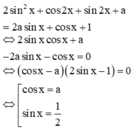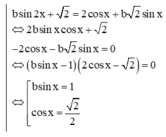Giải phương trình: 2cosx+tanx=1+2sin2x
Hãy nhập câu hỏi của bạn vào đây, nếu là tài khoản VIP, bạn sẽ được ưu tiên trả lời.


a) <=> 4sinxcosx -(2cos2x-1)=7sinx+2cosx-4
<=> 2cos2x+(2-4sinx)cosx+7sinx-5=0
- sinx=1 => 2cos2x-2cosx+2=0
pt trên vn
b) <=> 2sinxcosx-1+2sin2x+3sinx-cosx-1=0
<=> cos(2sinx-1)+2sin2x+3sinx-2=0
<=> cosx(2sinx-1)+(2sinx-1)(sinx+2)=0
<=> (2sinx-1)(cosx+sinx+2)=0
<=> sinx=1/2 hoặc cosx+sinx=-2(vn)
<=> x= \(\frac{\pi}{6}+k2\pi\) hoặc \(x=\frac{5\pi}{6}+k2\pi\left(k\in Z\right)\)

Lời giải:
ĐK:..................
PT \(\Leftrightarrow \tan x+\frac{1}{\tan x}+\frac{2}{\tan 2x}(1-2\cos x)=2\)
\(\Leftrightarrow \frac{\tan ^2x+1}{\tan x}+\frac{1-\tan ^2x}{\tan x}(1-2\cos x)=2\)
\(\Leftrightarrow \tan ^2x+1+(1-\tan ^2x)(1-2\cos x)=2\tan x\)
\(\Leftrightarrow (\tan x-1)^2-(\tan x-1)(\tan x+1)(1-2\cos x)=0\)
\(\Leftrightarrow (\tan x-1)[\tan x-1-(\tan x+1)(1-2\cos x)]=0\)
Nếu $\tan x-1=0$ thì $x=k\pi +\frac{\pi}{4}$
Nếu $\tan x-1-(\tan x+1)(1-2\cos x)=0$
$\Leftrightarrow (\tan x+1)\cos x=1$
$\Leftrightarrow (\frac{\sin x}{\cos x}+1)\cos x=1$
$\Leftrightarrow \sin x+\cos x=1$
$\Rightarrow (\sin x+\cos x)^2=1$
$\Leftrightarrow 1+2\sin x\cos x=1$
$\Leftrightarrow \sin x\cos x=0$ (trái điều kiện xác định)
Vậy...............
Lời giải:
ĐK:..................
PT \(\Leftrightarrow \tan x+\frac{1}{\tan x}+\frac{2}{\tan 2x}(1-2\cos x)=2\)
\(\Leftrightarrow \frac{\tan ^2x+1}{\tan x}+\frac{1-\tan ^2x}{\tan x}(1-2\cos x)=2\)
\(\Leftrightarrow \tan ^2x+1+(1-\tan ^2x)(1-2\cos x)=2\tan x\)
\(\Leftrightarrow (\tan x-1)^2-(\tan x-1)(\tan x+1)(1-2\cos x)=0\)
\(\Leftrightarrow (\tan x-1)[\tan x-1-(\tan x+1)(1-2\cos x)]=0\)
Nếu $\tan x-1=0$ thì $x=k\pi +\frac{\pi}{4}$
Nếu $\tan x-1-(\tan x+1)(1-2\cos x)=0$
$\Leftrightarrow (\tan x+1)\cos x=1$
$\Leftrightarrow (\frac{\sin x}{\cos x}+1)\cos x=1$
$\Leftrightarrow \sin x+\cos x=1$
$\Rightarrow (\sin x+\cos x)^2=1$
$\Leftrightarrow 1+2\sin x\cos x=1$
$\Leftrightarrow \sin x\cos x=0$ (trái điều kiện xác định)
Vậy...............

c/
\(\Leftrightarrow1-cos^2\frac{x}{2}-2cos\frac{x}{2}+2=0\)
\(\Leftrightarrow cos^2\frac{x}{2}+2cos\frac{x}{2}-3=0\)
\(\Leftrightarrow\left[{}\begin{matrix}cos\frac{x}{2}=1\\cos\frac{x}{2}=-3< -1\left(l\right)\end{matrix}\right.\)
\(\Leftrightarrow\frac{x}{2}=k2\pi\)
\(\Leftrightarrow x=k4\pi\)
d/ ĐKXĐ: ...
\(\Leftrightarrow tanx-\frac{2}{tanx}+1=0\)
\(\Leftrightarrow tan^2x+tanx-2=0\)
\(\Leftrightarrow\left[{}\begin{matrix}tanx=1\\tanx=-2\end{matrix}\right.\)
\(\Leftrightarrow\left[{}\begin{matrix}x=\frac{\pi}{4}+k\pi\\x=arctan\left(-2\right)+k\pi\end{matrix}\right.\)
a/
\(\Leftrightarrow\left(cosx-1\right)\left(2cosx-1\right)=0\)
\(\Leftrightarrow\left[{}\begin{matrix}cosx=1\\cosx=\frac{1}{2}\end{matrix}\right.\)
\(\Leftrightarrow\left[{}\begin{matrix}x=k2\pi\\x=\pm\frac{\pi}{3}+k2\pi\end{matrix}\right.\)
b \(\Leftrightarrow2sin2x+2\sqrt{2}sin2x.cos2x=0\)
\(\Leftrightarrow2sin2x\left(1+\sqrt{2}cos2x\right)=0\)
\(\Leftrightarrow\left[{}\begin{matrix}sin2x=0\\cos2x=-\frac{\sqrt{2}}{2}\end{matrix}\right.\)
\(\Leftrightarrow\left[{}\begin{matrix}2x=k\pi\\2x=\pm\frac{3\pi}{4}+k2\pi\end{matrix}\right.\)
\(\Leftrightarrow\left[{}\begin{matrix}x=\frac{k\pi}{2}\\x=\pm\frac{3\pi}{8}+k\pi\end{matrix}\right.\)

a, ĐK: \(x\ne\dfrac{5\pi}{6}+k2\pi;x\ne\dfrac{\pi}{6}+k2\pi\)
\(\dfrac{2sin^2\left(\dfrac{3x}{2}-\dfrac{\pi}{4}\right)+\sqrt{3}cos^3x\left(1-3tan^2x\right)}{2sinx-1}=-1\)
\(\Leftrightarrow2sin^2\left(\dfrac{3x}{2}-\dfrac{\pi}{4}\right)+\sqrt{3}cos^3x\left(1-3tan^2x\right)=1-2sinx\)
\(\Leftrightarrow-cos\left(3x-\dfrac{\pi}{2}\right)+\sqrt{3}cos^3x.\dfrac{cos^2x-3sin^2x}{cos^2x}=-2sinx\)
\(\Leftrightarrow-sin3x+\sqrt{3}cosx.\left(cos^2x-3sin^2x\right)=-2sinx\)
\(\Leftrightarrow-sin3x+\sqrt{3}cosx.\left(4cos^2x-3\right)=-2sinx\)
\(\Leftrightarrow-sin3x+\sqrt{3}cos3x=-2sinx\)
\(\Leftrightarrow\dfrac{1}{2}sin3x-\dfrac{\sqrt{3}}{2}cos3x-sinx=0\)
\(\Leftrightarrow sin\left(3x-\dfrac{\pi}{3}\right)-sinx=0\)
\(\Leftrightarrow2cos\left(2x-\dfrac{\pi}{6}\right)sin\left(x-\dfrac{\pi}{6}\right)=0\)
\(\Leftrightarrow\left[{}\begin{matrix}cos\left(2x-\dfrac{\pi}{6}\right)=0\\sin\left(x-\dfrac{\pi}{6}\right)=0\end{matrix}\right.\)
\(\Leftrightarrow\left[{}\begin{matrix}2x-\dfrac{\pi}{6}=\dfrac{\pi}{2}+k\pi\\x-\dfrac{\pi}{6}=k\pi\end{matrix}\right.\)
\(\Leftrightarrow\left[{}\begin{matrix}x=\dfrac{\pi}{3}+\dfrac{k\pi}{2}\\x=\dfrac{\pi}{6}+k\pi\end{matrix}\right.\)
Đối chiếu điều kiện ta được:
\(\Leftrightarrow\left[{}\begin{matrix}x=\dfrac{\pi}{3}+k\pi\\x=\dfrac{7\pi}{6}+k2\pi\\x=-\dfrac{\pi}{6}+k2\pi\end{matrix}\right.\)
(Giả sử chọn k=-1)
Đặt \(u_n=v_n-1\Rightarrow v_{n+1}-1=\dfrac{5\left(v_n-1\right)+4}{v_n-1+2}=\dfrac{5v_n-1}{v_n+1}\)
\(\Rightarrow v_{n+1}=1+\dfrac{5v_n-1}{v_n+1}=\dfrac{6v_n}{v_n+1}\)
Mục đích chỉ cần biến đổi tới đây, sau đó nghịch đảo 2 vế:
\(\Rightarrow\dfrac{1}{v_{n+1}}=\dfrac{v_n+1}{6v_n}=\dfrac{1}{6v_n}+\dfrac{1}{6}\)
Đặt \(\dfrac{1}{v_n}=x_n\Rightarrow\left\{{}\begin{matrix}x_1=\dfrac{1}{v_1}=\dfrac{1}{u_1+1}=\dfrac{1}{6}\\x_{n+1}=\dfrac{1}{6}x_n+\dfrac{1}{6}\end{matrix}\right.\)
Rồi đó, đưa về dãy cơ bản \(\Rightarrow x_{n+1}-\dfrac{1}{5}=\dfrac{1}{6}\left(x_n-\dfrac{1}{5}\right)\)
Đặt \(x_n-\dfrac{1}{5}=y_n\Rightarrow\left\{{}\begin{matrix}y_1=x_1-\dfrac{1}{5}=-\dfrac{1}{30}\\y_{n+1}=\dfrac{1}{6}y_n\end{matrix}\right.\)
\(\Rightarrow y_n=-\dfrac{1}{30}\left(\dfrac{1}{6}\right)^{n-1}\Rightarrow x_n=y_n+\dfrac{1}{5}=-\dfrac{1}{30}.\left(\dfrac{1}{6}\right)^{n-1}+\dfrac{1}{5}\)
\(\Rightarrow v_n=\dfrac{1}{x_n}=...\Rightarrow u_n=v_n-1=\dfrac{1}{x_n}-1=...\)
Cách này là cách cơ bản, có hướng làm cố định để đưa về các dãy quen thuộc

câu 1
⇒ \(\dfrac{cosx}{sinx}\) - \(\dfrac{sinx}{cosx}\) -\(\dfrac{2cos4x}{2sinxcosx}\) =0
⇔ \(\dfrac{cos^2x-sin^2x}{sinx.cosx}\) -\(\dfrac{cos4x}{sinx.cosx}\)= 0
⇔ \(\dfrac{cos2x-cos4x}{sinx.cosx}\) = 0
\(\left[{}\begin{matrix}cos2x=cos4x\\sin2x=0\end{matrix}\right.\Leftrightarrow\left[{}\begin{matrix}2x=4x+k2\pi\\2x=-4x+k2\pi\\2x=k\pi\end{matrix}\right.\Leftrightarrow\left[{}\begin{matrix}x=-k\pi\\x=\dfrac{k\pi}{3}\\x=\dfrac{k\pi}{2}\end{matrix}\right.\) (k∈ Z)
câu 2 dùng công thức biến đổi tích thành tổng thành cos 4x + cos 2x sau đó phương trình trở thành sin x - cos 4x=0




 => x =
=> x =
ĐKXĐ:...
\(2cosx+\frac{sinx}{cosx}=1+4sinx.cosx\)
\(2cos^2x+sinx=cosx+4sinx.cos^2x\)
\(\Leftrightarrow sinx\left(4cos^2x-1\right)-\left(2cos^2x-cosx\right)=0\)
\(\Leftrightarrow sinx\left(2cosx+1\right)\left(2cosx-1\right)-cosx\left(2cosx-1\right)=0\)
\(\Leftrightarrow\left(2cosx-1\right)\left(2sinx.cosx+sinx-cosx\right)=0\)
\(\Leftrightarrow...\)